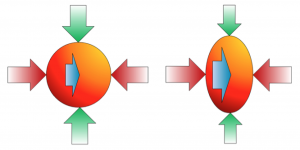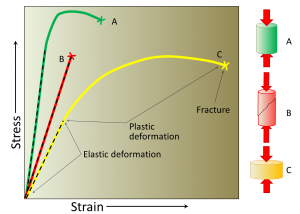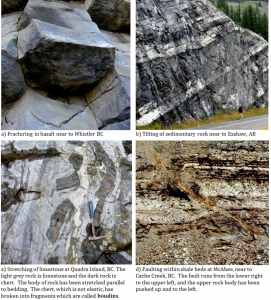10.1 Stress and Strain

Rocks are subject to stress—mostly related to plate tectonics but also to the weight of overlying rocks—and their response to that stress is strain (deformation). In regions close to where plates are converging stress is typically compressional—the rocks are being squeezed. Where plates are diverging the stress is tensional—rocks are being pulled apart. At transform plate boundaries, where plates are moving side by side there is sideways or shear stress—meaning that there are forces in opposite directions parallel to a plane. Rocks have highly varying strain responses to stress because of their different compositions and physical properties, and because temperature is a big factor and rock temperatures within the crust can vary greatly.
We can describe the stress applied to a rock by breaking it down into three dimensions—all at right angles to one-another (Figure 10.1.1). If the rock is subject only to the pressure of burial, the stresses in all three directions will likely be the same. If it is subject to both burial and tectonic forces, the pressures will be different in different directions.

Rock can respond to stress in three ways: it can deform elastically, it can deform plastically, and it can break or fracture. Elastic strain is reversible; if the stress is removed, the rock will return to its original shape just like a rubber band that is stretched and released. Plastic strain is not reversible. As already noted, different rocks at different temperatures will behave in different ways to stress. Higher temperatures lead to more plastic behaviour. Some rocks or sediments are also more plastic when they are wet. Another factor is the rate at which the stress is applied. If the stress is applied quickly (for example, because of an extraterrestrial impact or an earthquake), there will be an increased tendency for the rock to fracture. Some different types of strain response are illustrated in Figure 10.1.2.
The outcomes of placing rock under stress are highly variable, but they include fracturing, tilting and folding, stretching and squeezing, and faulting. A fracture is a simple break that does not involve significant movement of the rock on either side. Fracturing is particularly common in volcanic rock, which shrinks as it cools. The basalt columns in Figure 10.1.3a are a good example of fracture. Beds are sometimes tilted by tectonic forces, as shown in Figure 10.1.3b, or folded.

When a body of rock is compressed in one direction it is typically extended (or stretched) in another. This is an important concept because some geological structures only form under compressional stress, while others only form under tensional stress. Most of the rock in Figure 10.1.3c is limestone, which is relatively weak and easily deformed when heated. The dark rock is chert, which is relatively stronger and remains brittle. As the limestone stretched (parallel to the hammer handle) the brittle chert was forced to break into fragments to accommodate the change in shape of the body of rock. Figure 10.1.3d shows another type of brittle structure called a fault. Like fractures, faults result from brittle breaking of a rock unit. The key difference is that the bodies of rock on either side of the fault have been displaced relative to each other by the faulting.
Media Attributions
- Figures 10.1.1, 10.1.2, 10.1.3: © Steven Earle. CC BY.
describes the force per unit area that acts on a rock unit to change its shape or volume
the deformation of rock that is subjected to stress
In geology, deformation refers to folding (ductile bending) or faulting and fracturing (brittle breaking) of rocks in response to stress.
stress that tends to squeeze something together
stress that tends to pull something apart
the stress placed on a body of rock or sediment adjacent to a fault
the deformed rock returns to its original shape and size when the deforming stress is removed
The deformed rock cannot return to an un-deformed state once the deforming stress is removed. Irreversible strain.
A break within a body of rock in which the rock on either side is not displaced.
a boundary in rock or sediment along which displacement has taken place

